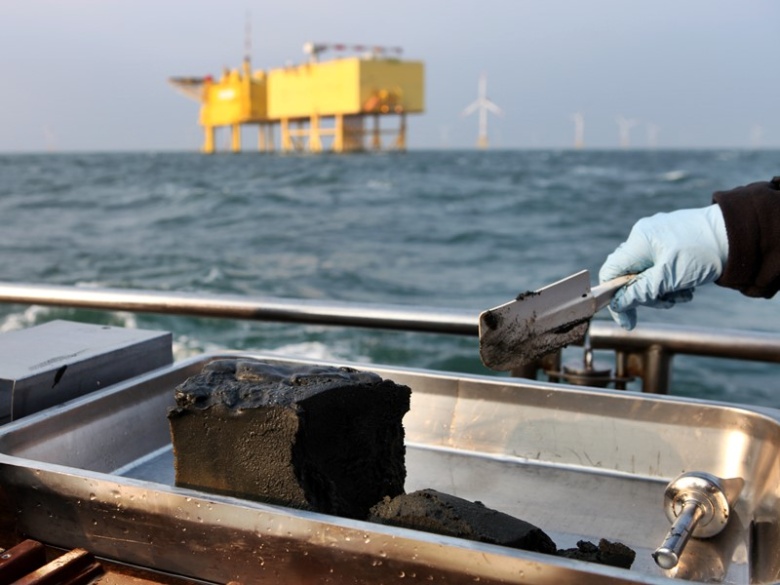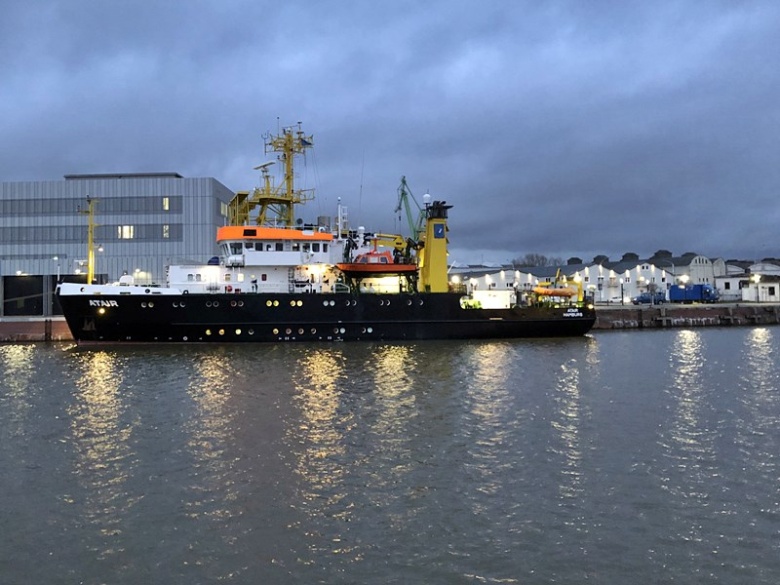OffChEm & OffChEm II (2017 – 2023)
Chemical emissions from offshore wind farms – Potential impacts on the marine environment and their evaluation

(Photo: Sabine Billerbeck/Hereon)
The progressive expansion of offshore wind energy in the North Sea and Baltic Sea is accompanied by an increasing intrusion into the marine environment. More than 1,500 offshore wind turbines and at least 20 converter and transformer platforms have already been erected (as of December 2021). Each offshore installation represents an intervention in the marine environment. Material releases from these installations have hardly been investigated to date. The main issues here are the necessary measures for corrosion protection and the use of operational materials. Scientific knowledge about the quantities released and their distribution in the respective environmental compartments (water, sediment, biota) is currently scarce. A comprehensive assessment of the effects on the marine environment is therefore only possible to a limited extent based on current knowledge.
Focus on corrosion protection
Galvanic anodes (so-called "sacrificial anodes") are used to protect offshore installations from corrosion, as a result of which large quantities of metal compounds (especially compounds of aluminum and zinc) are continuously discharged into the marine environment during the course of operation of the installation. In addition to the main components, galvanic anodes also contain other metallic secondary components (e.g. indium, lead, cadmium as well as other heavy metals), which are also discharged into the marine environment when the anodes melt down.
Aims of the project
In the project OffChEm and its follow-on project OffChEm II, funded by the Federal Maritime and Hydrographic Agency (BSH), the Hereon investigates the following aspects in collaboration with the BSH:
- Identification of potential inorganic (harmful) substances which could have a relevant impact on the marine environment through the corrosion protection of offshore wind farms.
- Development of analytical methods and suitable sampling strategies to determine the emissions of the potential substances in the various compartments in the vicinity of offshore wind farms.
- Evaluation of the relevance of the identified potential pollutants on the basis of their chemical emissions from offshore wind farms and their influence on the local and regional marine environment.
Within the framework of OffChEm and OffChEm II, offshore wind farms in the North Sea and Baltic Sea were and are sampled. Since 2016, sampling campaigns have been conducted at least once a year on research vessels from BSH and Hereon to collect water and sediment samples.
Reports on selected campaigns can be found at the following links:
Campaign 2019 in the North Sea: Measurement campaign on the "Atair" and Measurement campaign on the "Atair" - Second attempt (in German).
2020 campaign in the North Sea on the Ludwig Prandtl: Instagram highlight "Takeover"
Campaign 2021 in the Baltic Sea on the Ludwig Prandtl: Baltic Sea campaign successfully completed (in German).
25.07. – 05.08.2016: In a first survey the surrounding of different offshore wind farms in the North Sea close to the coast line were sampled with the research vessel "Ludwig Prandtl" (Hereon).
31.05 – 06.06.2017: In the course oft he BSH monitoring with the research vessel Atair first test samples were taken inside offshore wind farms and from areas that are planned to become offshore wind farms in the future.
17.07.-19.07.2017: Sampling campaign in the wind farm "DanTysk" and areas close to Sylt’s coast line. The aim was to gain insights into the influence of singles wind turbines on water currents and turbulences. In addition water samples were taken for the analysis of trace metals.
10.04.-16.04.2018: A first high-resolution sampling of different offshore wind farms in the North Sea was accomplished with the research vessel "Atair" (BSH). In total, at more than 50 sampling stations water, sediment and particulate matter samples were taken.
05.03.-14.03.2019: For insights into temporal changes in pollution load samples stations from previous sampling campaigns were sampled again. In total almost 100 water, sediment and particulate matter samples were taken in and around offshore wind farms in the North Sea. More on this campaign in these blog posts (in German):
Messkampagne auf der "Atair"
Messkampagne auf der "Atair" - Zweiter Anlauf
22.07.-25.07.2020: The corona pandemic is also messing up the OffChEm plans. Instead of going in April with the new ship "Atair" of the BSH, the Hereon's vessel "Ludwig Prandtl" will go to the North Sea in July. We drive from Cuxhaven to Heligoland under strict hygiene measures and with a thinned-out sampling plan. From Heligoland, we then test individual wind farms in day trips. In the end we bring 40 water and 30 sediment samples back to Geesthacht More about this campaign can be found in the Hereon's Instagram-Highlight „Takeover“
Impressions from sampling campaigns
- (08/2022) Press release: Offshore wind farms: Components of corrosion protection detected in the North Sea
- (05/2022) Poster presentation at the conference Wasser 2022: Klein, O., Zimmermann, T., Ebeling, A., Kruse, M., Kirchgeorg, T., Pröfrock, D., Technologie-kritische Elemente - Entwicklung und Anwendung einer ICP-MS/MS basierten Methode zur Messung ihrer zeitlichen Variationen in Nordsee Sedimenten
- (04/2022) Publication: Klein, O., Zimmermann, T., Ebeling, A., Kruse, M., Kirchgeorg, T., & Pröfrock, D. (2022): Occurrence and Temporal Variation of Technology-Critical Elements in North Sea Sediments - A Determination of Preliminary Reference Values. Arch Environ Contam Toxicol (2022), doi:10.1007/s00244-022-00929-4
- (04/2022) Measurement campaign in the North Sea onboard oft he Atair
- (02/2022) Publication: Ebeling, A., Zimmermann, T., Klein, O., Irrgeher, J., & Pröfrock, D. (2022): Analysis of Seventeen Certified Water Reference Materials for Trace and Technology-Critical Elements. Geostand Geoanal Res., doi:10.1111/ggr.12422
- (07/2021) Baltic Sea campaign successfully completed (in German). Baltic Sea campaign successfully completed (in German)
- (07/2021) Start of OffChEm II
- (05/2021) Presentation at 52th Liege Colloquium on Ocean Dynamics: Towards an understanding and assessment of human impact on coastal marine environments: A. Ebeling (Reese), D. Obergfäll, C. Pehlke, J. Ludwig, M. Kruse, O. Klein, T. Zimmermann, N. Voigt, B. Erbslöh, T. Kirchgeorg, I. Weinberg, J. Irrgeher, D. Pröfrock, Corrosion protection
- (11/2020) Invited lecture in the online seminar of the Department General, Analytical and Physical Chemistry of the Montanuniversität Leoben, Austria: A. Ebeling, D. Obergfäll, C. Pehlke, T. Zimmermann, N. Voigt, B. Erbslöh, T. Kirchgeorg, I. Weinberg, J. Irrgeher, D. Pröfrock; Elemental and isotopic analysis for the identification and assessment of emissions from Offshore Wind Farms
- (07/2020) Sampling campaign on the "Ludwig Prandtl" completed
- (06/20) Publication: Reese, A., Voigt, N., Zimmermann, T., Irrgeher, J., & Pröfrock, D. (2020): Characterization of alloying components in galvanic anodes as potential environmental tracers for heavy metal emissions from offshore wind structures. Chemosphere, Volume 257, 127182, doi:10.1016/j.chemosphere.2020.127182
- (01/2020) Highlight Topic: Wind parks as a pollutant source?
- (11/2019) Poster presentation and flash talk at the Symposium on marine resources and offshore wind farms 2019, Bremerhaven, Germany: A. Reese, D. Obergfäll, N. Voigt, B. Erbslöh, T. Zimmermann, T. Kirchgeorg, I. Weinberg, J. Irrgeher, D. Pröfrock, Corrosion protection of offshore wind farms: An emerging contamination source for the marine environment?
- (08/2019) Oral presentation at the Goldschmidt2019 in Barcelona, Spain: A. Reese, N. Voigt, T. Zimmermann, T. Kirchgeorg, I. Weinberg, J. Irrgeher, D. Pröfrock, Corrosion protection of offshore wind farms: An emerging inorganic contamination source for the marine environment?
- (07/2019) The project duration was officially extended up to and including June 2021.
- (04/2019) Blog post (German): Messkampagne auf der ATAIR - zweiter Anlauf
- (03/2019) Blog post (German): Messkampagne auf der ATAIR
- (03/2019) Poster presentations at the ANAKON2019 in Münster, Germany: A. Reese, N. Voigt, T. Zimmermann, J. Irrgeher, D. Pröfrock, Characterization of galvanic anode material for corrosion protection of offshore wind farms by (laser ablation) inductively coupled plasma mass spectrometry. T. Zimmermann, A. Reese, N. Voigt, J. Irrgeher, D. Pröfrock, Online matrix separation coupled to inductively coupled plasma tandem mass spectrometry (ICP-MS/MS) for the ultra-trace analysis of seawater.
- (02/2019) Poster presentation at the EWCPS2019 in Pau, France: A. Reese, N. Voigt, T. Zimmermann, J. Irrgeher, D. Pröfrock, Corrosion protection of offshore wind farms: a new potential source of inorganic contaminants for the marine environment?
- (09/2018) Poster presentation at the 26. ICPMS-Anwendertreffen in Berlin, Germany: A. Reese, N. Voigt, T. Zimmermann, J. Irrgeher, D. Pröfrock, Charakterisierung galvanischer Anodenmaterialien zur Identifizierung potentieller Tracer für anorganische Kontaminanten aus Offshore-Windparks.
- (06/2018) ) Article in in2scinece #6: „Test the storm“
- (06/2018) Poster presentation at the Nordic Plasma 2018 in Loen, Norway: A. Reese, N. Voigt, T. Zimmermann, J. Irrgeher, D. Pröfrock, Offshore wind constructions: Corrosion protection as a new potential source of inorganic contaminants into the marine environment.
- (08/2017) Poster presentation at the Goldschmidt2017 in Paris, France: N. Voigt, T. Zimmermann, J. Irrgeher, D. Pröfrock, Investigation of the chemical impact of offshore structures on the German North Sea environment.
- (02/2017) Poster presentation at the EWCPS 2017 in St. Anton, Austria: N. Voigt, T. Zimmermann, J. Irrgeher, D. Pröfrock, Multi-elemental characterization of anode materials used for cathodic protection structures using ICP-MS/MS.
Publications
- Klein, O., Zimmermann, T., Ebeling, A., Kruse, M., Kirchgeorg, T., & Pröfrock, D. (2022): Occurrence and Temporal Variation of Technology-Critical Elements in North Sea Sediments - A Determination of Preliminary Reference Values. Arch Environ Contam Toxicol (2022), doi:10.1007/s00244-022-00929-4
- Ebeling, A., Zimmermann, T., Klein, O., Irrgeher, J., & Pröfrock, D. (2022): Analysis of Seventeen Certified Water Reference Materials for Trace and Technology-Critical Elements. Geostand Geoanal Res., doi:10.1111/ggr.12422
- Reese, A., Voigt, N., Zimmermann, T., Irrgeher, J., & Pröfrock, D. (2020): Characterization of alloying components in galvanic anodes as potential environmental tracers for heavy metal emissions from offshore wind structures. Chemosphere, Volume 257, 127182, doi:10.1016/j.chemosphere.2020.127182
Reports
Theses
Jonas Ludwig 2021
Bestimmung von Element- und Isotopenmustern in Sedimentproben aus verschiedenen Offshore Windparks der deutschen Nordsee zur Untersuchung möglicher stofflicher Freisetzung aus Korrosionsschutzsystemen, Bachelorarbeit, Hochschule Mannheim
Madita Kruse 2021
Zeitliche Entwicklung technologie-kritischer Elemente in Nordseesediment in Hinblick auf potenzielle Emissionen aus Offshore-Windparks“, Bachelorarbeit, TH Lübeck
Carlotta Pehlke 2020:
Untersuchung von Isotopensignaturen in Oberflächensedimenten aus Nordsee- Offshore-Windparks sowie deren Umfeld.
Bachelorarbeit, Leuphana Universität Lüneburg
Svenja Meers 2018:
Untersuchung der Elementverteilung in Oberflächensedimenten aus dem Umfeld ausgewählter Offshore Windparks im küstennahen Bereich der Nordsee.
Bachelorarbeit, FH Lübeck
Nathalie Voigt 2017:
Multielementcharakterisierung von Anodenmaterial für den kathodischen Korrosionsschutz an Offshore-Strukturen mittels ICP-MS/MS.
Bachelorarbeit, FH Lübeck














